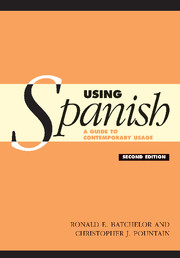Book contents
- Frontmatter
- Contents
- Authors' acknowledgements
- Preface to the second edition
- List of abbreviations and symbols
- Glossary
- The Spanish speaking world: countries where Spanish is spoken, with an estimate of the numbers of native speakers
- 1 Introduction
- 2 Passages illustrating register and local variety
- Part I Vocabulary
- Part II Grammar
- 21 Gender
- 22 Number
- 23 Word order
- 24 Prepositions
- 25 Prepositional constructions with verbs, nouns and adjectives
- 26 Constructions with verbs of movement
- 27 Negation
- 28 Use of tenses
- 29 Periphrastic verb forms
- 30 Modal auxiliaries
- 31 The Subjunctive
- 32 ser and estar
- 33 Personal pronouns
- 34 The reflexive
- 35 Comparison
- 36 Usage with names of countries
- Index
25 - Prepositional constructions with verbs, nouns and adjectives
Published online by Cambridge University Press: 05 June 2012
- Frontmatter
- Contents
- Authors' acknowledgements
- Preface to the second edition
- List of abbreviations and symbols
- Glossary
- The Spanish speaking world: countries where Spanish is spoken, with an estimate of the numbers of native speakers
- 1 Introduction
- 2 Passages illustrating register and local variety
- Part I Vocabulary
- Part II Grammar
- 21 Gender
- 22 Number
- 23 Word order
- 24 Prepositions
- 25 Prepositional constructions with verbs, nouns and adjectives
- 26 Constructions with verbs of movement
- 27 Negation
- 28 Use of tenses
- 29 Periphrastic verb forms
- 30 Modal auxiliaries
- 31 The Subjunctive
- 32 ser and estar
- 33 Personal pronouns
- 34 The reflexive
- 35 Comparison
- 36 Usage with names of countries
- Index
Summary
This is one of the most complex areas of Spanish grammar. The following sections outline some general principles and draw attention to the many differences between Spanish and English. All verbs, nouns and adjectives listed in this section are included in the Spanish word index at the end of the book.
note: The raised equals sign by a verb (=) indicates that in order for the verb to take an infinitive or gerund complement the subject of the verb and the implied subject of its dependent infinitive or gerund must be identical. For example, in aprendí (yo) a hacerlo (yo), yo is the subject of both aprendí and hacer (cf English Ilearned howIshould do it).
Verbs with no preposition before an infinitive
Infinitive as subject of the verb
If the infinitive is the subject of the verb, no intervening preposition is used: †aburrir (aiouno)(to be boring (to sb)) is such a verb. In the sentence Me aburre hacer eso, hacer eso is the subject of me aburre. Notice that the most usual English equivalent of such sentences is often not parallel in structure: Me aburre hacer eso might be translated as I'm bored doing that in preference to the more literal Doing that bores me.
- Type
- Chapter
- Information
- Using SpanishA Guide to Contemporary Usage, pp. 336 - 367Publisher: Cambridge University PressPrint publication year: 2005



